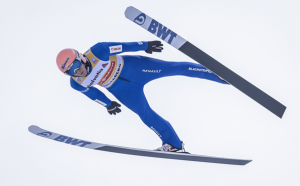Difference between revisions of "Multisensory system for performance analysis in ski jumping (M/1-2S/B)"
From iis-projects
| Line 1: | Line 1: | ||
[[File:SkiJumperInAir.png|thumb]] | [[File:SkiJumperInAir.png|thumb]] | ||
| − | + | ||
==Short Description== | ==Short Description== | ||
| + | This project focusses on the development of an unobtrusive multisensory embedded system to help ski jumpers and coaches to better quantify jumping performances. | ||
| + | |||
Within the short duration of a ski-jump (< 10 seconds) and exposed to the conditions of nature (snow, wind, temperature) athletes must solve extremely difficult optimisation problems. Flight trajectories of athletes are decisive for victory in a ski jumping competition. They are influenced by the properties of the inrun, the take-off speeds, the applied forces, the athletes’ body position as well as ski edging angles during flight. Due to the complexity of such a flight situation sensors and devices attached to the body must be imperceptible to athletes to not interfere with the athlete's sensible jumping system. | Within the short duration of a ski-jump (< 10 seconds) and exposed to the conditions of nature (snow, wind, temperature) athletes must solve extremely difficult optimisation problems. Flight trajectories of athletes are decisive for victory in a ski jumping competition. They are influenced by the properties of the inrun, the take-off speeds, the applied forces, the athletes’ body position as well as ski edging angles during flight. Due to the complexity of such a flight situation sensors and devices attached to the body must be imperceptible to athletes to not interfere with the athlete's sensible jumping system. | ||
Revision as of 14:56, 29 January 2023
Contents
Short Description
This project focusses on the development of an unobtrusive multisensory embedded system to help ski jumpers and coaches to better quantify jumping performances.
Within the short duration of a ski-jump (< 10 seconds) and exposed to the conditions of nature (snow, wind, temperature) athletes must solve extremely difficult optimisation problems. Flight trajectories of athletes are decisive for victory in a ski jumping competition. They are influenced by the properties of the inrun, the take-off speeds, the applied forces, the athletes’ body position as well as ski edging angles during flight. Due to the complexity of such a flight situation sensors and devices attached to the body must be imperceptible to athletes to not interfere with the athlete's sensible jumping system.
Status: Available
- Looking for 1-2 Semester/Master students
- Contact: Christoph Leitner
Prerequisites
- VLSI I
- VLSI II (recommended)
Character
- 20% Theory
- 40% ASIC Design
- 40% EDA tools
